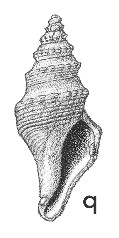
Revised descriptions of New Zealand Cenozoic Mollusca from Beu and Maxwell (1990)

 | Revised descriptions of New Zealand Cenozoic Mollusca from Beu and Maxwell (1990) | 
|
  (Pl. 49q): holotype of Pleurotoma gemmea Murdoch, Castlecliff, Wanganui, Castlecliffian (TM6842, GNS, ex Marshall and Murdoch Collection) |
Beu & Maxwell (1990): Chapter 16; p. 368; pl. 49 q.
Synonymy: Pleurotoma gemmea Murdoch 1900, p. 217; Surcula castlecliffensis Marshall & Murdoch 1919, p. 255
Type species (as S. castlecliffensis) of Paracomitas Powell, 1942
Classification: Turridae: Cochlespirinae
Description: Moderate-sized for family (15-19 mm high), tall and narrow, with moderately tall, strongly stepped spire, prominent shoulder angulation at half whorl height on spire whorls, weak peribasal angulation on last whorl, and moderately long, straight anterior canal without fasciole. Sculpture of low, narrow, closely spaced spiral cords over entire surface below shoulder, 6-8 on spire whorls and about 20 on last whorl, and of low, closely spaced, oblique nodules around peripheral keel, short and occupying only 1 or 2 spiral cords; 15-22 nodules per whorl. Anal sinus broad, rather shallowly U-shaped, occupying strongly concave sutural ramp. Aperture simple, lips thin, without parietal callus. Protoconch relatively tall, of 2.5 whorls, with a low, blunt apex, smooth except for a prominent, sharp, median keel.
Comparison: Powell (1942) distinguished Paracomitas castlecliffensis from P. gemmea by the smaller and more numerous nodules (20-22) of P. castlecliffensis and the fewer nodules (16) and more protruding shoulder carina of P. gemmea, but larger collections of shells from Castlecliff show that these sculptural variants intergrade completely (Maxwell 1988a, p. 60). P. protransenna (Nukumaruan; Pl. 42r) has a more prominent peribasal angulation than that of P. gemmea, and lacks nodules around the shoulder carina; the Recent P. augusta (Murdoch and Suter) also has a more prominent peribasal angulation and more prominent nodules than P. gemmea.
Distribution: Castlecliffian. "Blue-clay cliffs, west of Wanganui Heads", i.e., Castlecliff section, Wanganui, Castlecliffian (type of Pleurotoma gemmea); "Castlecliff, in blue sandy clay", Castlecliffian (type of Surcula castlecliffensis); moderately common in offshore siltstone beds (notably Tainui Shellbed and the Kai-Iwi siltstone units) at Castlecliff, Wanganui, but the sole other record we are aware of is from the uppermost part of Mikonui-1 well, drilled in 159 m of water off Hokitika, Westland (Beu 1981b).
Cite this publication as: "A.G. Beu and J.I. Raine (2009). Revised
descriptions of New Zealand Cenozoic Mollusca from Beu and Maxwell (1990). GNS
Science miscellaneous series no. 27."
© GNS Science, 2009
ISBN
978-0-478-19705-1
ISSN 1177-2441
(Included with a PDF facsimile file
copy of New Zealand Geological Survey Paleontological Bulletin 58 in CD version
from: Publications Officer, GNS Science, P.O. Box 30368 Lower Hutt, New
Zealand)